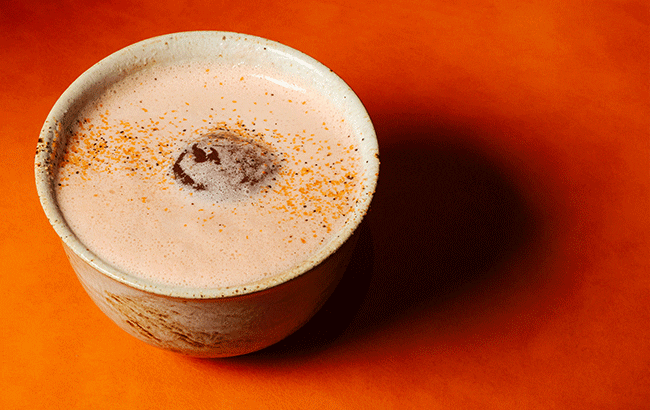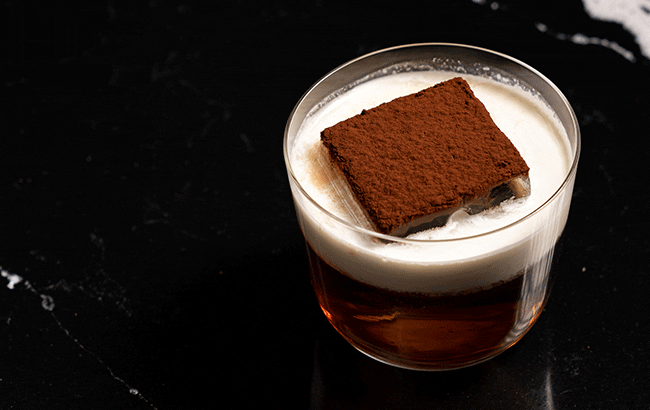How is food inspiring modern mixology?
The lines between the kitchen and the bar have never been more blurred as culinary-inspired cocktails grow in prominence.

*This feature was originally published in the August 2024 issue of The Spirits Business magazine.
The old adage says that just because you can do something, doesn’t mean you should do it. Ten years ago this may have applied to ideas like trying to recreate the taste of a pizza in a cocktail, but times have changed. Done right and within reason, culinary cocktails can have a lot of depth, and appeal to today’s drinkers. However, it is a little more complicated than just slapping together the ingredients of a dish with alcohol and calling it a cocktail. There are many layers to this form of cocktail service, as some of the world’s top bartenders explain.
In New York, some may point to Double Chicken Please as the one that really took the food-inspired cocktail from novel to normal.
In 2023 the bar was ranked second in the World’s 50 Best Bars list, and in its backroom space, The Coop, much of the menu is based around recognisable food items, from pizza to French toast. “We were not really expecting it to become a trend,” says Tako Chang, the bar’s manager of brand marketing and communications. “Our founders [GN Chan and Faye Chen] have travelled around the world, and love their food”.
Dinner menu
The list at the bar almost reads like a dinner menu, divided between appetisers, mains, and desserts. “You can start with shroom [mushroom] ceviche to refresh your palate, then move onto Thai Curry, where you get a little bit savoury, and then end with custard bun, where you get the sweet, salted egg yolk flavour just like the traditional Cantonese dish,” explains Chang. The menu is like a dinner, a progress through courses. “We like to have fun with the dishes and trick our guests a little with the flavours,” says Chang. “We want to make them giggle, in a way.”
It’s not to say these types of drinks have the exact ingredients of their food counterparts. Chang says the bar “takes key components from dishes and applies them in the cocktail where they make sense” – ‘sense’ being the important word. The Cold Pizza (containing Tequila, Parmigiano Reggiano, burnt toast, tomato, basil, honey and egg white), which has received a lot of attention, is the bar’s take on a Bloody Mary, the original cocktail with culinary designs. “The idea was how do we make it taste more like a pizza? We’re in New York. You have to have that on the menu.”
This extends to a wider trend where the world of restaurants and bars are starting to meet in the middle. Chang says: “In New York, restaurants have been investing lots into their cocktail programmes, and the same goes for bars for their food menus.”
Equal footing
At F*nkytown, in Bangkok, Thailand, food and drink are given equal footing, with proper full-sized shareable dishes offered, alongside the cocktails. Beverage manager Pae Ketumarn says: “After Covid-19, the trend for cocktails in Bangkok, and Southeast Asia, has shifted from classic cocktails to culinary-driven ideas and sustainability.”
F*unkytown hosts kitchen takeovers and collaborations, and Ketumarn notes that creating a signature menu inspired by cuisine is on-brand for the bar. Drinks such as Green Curry, Carrot Cake, and Som Tum (Thai for papaya salad) are among the food-esque inventions. For the Green Curry – made with green curry spices, Stranger & Sons gin, cucumber, pineapple, and egg white – Ketumarn juxtaposed the ingredients in a drinkable way, while representing the flavours and experience of the curry.

“The curry is quite thick because of the coconut cream. We decided to do a different take. We don’t do the creamy version, we wanted to do something a bit more refreshing and light. We still use all the original ingredients, like coconut, but use coconut syrup instead – and in the green curry paste, you would have a bunch of spices like white peppercorn, fennel seeds, coriander seeds, so we use those spices in our infusion of the gin. For lack of a better word, we sort of ‘bastardise’ the original idea by giving it a different lens.”
In Hong Kong, Avoca – a new bar in the Mondrian hotel – has designed a menu with cocktails that nod to the city’s delicacies and street food. Claypot rice, mango pomelo, and ingredients such as peanut butter and sesame seeds that you might find in rice noodles are incorporated into drinks. The Claypot Negroni – created with purified water from a clay pot – is mellower than the standard version, while the Mango Pomelo Colada is like a clarified Piña Colada, drawn from both the mango pomelo sago dessert, and bar director Joe Villanueva’s memories of drinking Piña Coladas in the pubs around the area. “Most of these cocktails are tweaks on commonly consumed cocktails, so it’s actually quite safe,” Villanueva says.
In France, the team at CopperBay recently opened their third site, at the Hôtel Lancaster in Paris, and the signature drinks menu is built around popular dishes from southern European countries. It has a “Mediterranean DNA”, says co-owner and bartender Aurélie Panhelleux (main photo). “The idea was to select dishes that people can really identify with, as if someone hasn’t tried a dish before it doesn’t make much sense.”
One drink that takes after a tiramisu has the same profile as the Italian dessert, both visually and in terms of taste. “It’s the whole experience – we clarify the drink and infuse it with mascarpone,” explains Panhelleux. “Most people have tried tiramisu, so when you drink it it has the impact of ‘oh my god, it really tastes like a tiramisu’.”
Another drink that has identifiable qualities is the Tapenade, a twist on a Dry Martini. “In France we are used to black olive cream [we infuse tapenade in the gin] and eat a lot of it in the south, like on bread with an aperitivo. It’s also works for a lot of people from the US and the UK because they love the saltiness and the fact that it looks like a Dirty Martini. You have the same profile going on.”
For the Pan Con Tomate, the team uses shochu to bring the taste of toasted bread. “You have to do it very wisely. The idea is not to just put the same ingredients and food into the drinks, and bam it works. It’s a matter of if these ingredients, which are basically in the dish, work in the drink – yes or no. If not, you need to look at what can give the same flavour profile and the same experience.”
Related news
The Radicle brings $10 cocktails to Chicago
